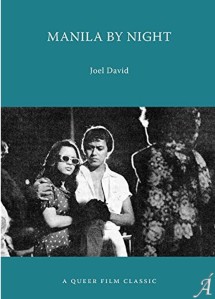The following is a translation of Chuckberry J. Pascual’s “Mahalaga ang Marami: Rebyu ng Manila by Night: A Queer Film Classic ni Joel David [The Masses Matter: A Review of Manila by Night: A Queer Film Classic by Joel David],” published in Pelikula [Film]: A Journal of Philippine Cinema 5 (2020), pp. 76-77. The excerpted pages may be found on this link, while the complete issue may be found on the journal website.
Joel David’s Manila by Night: A Queer Film Classic (2017) may be read in many ways, because like the multiple-character film it champions, the book also offers a myriad of narratives and discourses.
11011Here’s an example: film is history. David links the film narrative with the story of the nation, which may be read as a continuation of the assertion of film attendance as our national pastime. And why not? In the first chapter, David mapped how the histories of film as well as of the Philippines share the same umbilical cord. And its Janus-like opposite, rarely mentioned because of how painful it is to articulate and accept: the colonial nature of the country (also reflected in how Bernal’s work builds on the innovation of Robert Altman’s Nashville). David provides more of such explications and recollections in the book, as in his take on the common view of the years between the two Golden Ages of Philippine Cinema. In contrast with Lumbera’s pronouncement that this was a period of “rampant commercialism and artistic decline,” David counters that “In fact, the 1960s was marked by a pioneering, taboo-breaking, politically charged vulgarity never seen before or since in the country, which is essential to explaining why the Second Golden Age (1975-86) held far more promise and managed to meet more expectations than the first.” This revelation is significant because it deals with the same period where Manila by Night is set, particularly its narrative emphasis on genders and sexualities of individuals considered outsiders, eccentric, if not riffraff.
11011In historicizing Manila by Night, David gives weight to Bernal’s biographical background. (It may be tempting to use the word “development,” but like his film, Bernal did not evolve in linear fashion. As David put it, Manila by Night was a “mid-career work” even if it did not mark the start or the end of Bernal’s tinkering with multiple-character format films.) And Bernal and his film will never be fully comprehended unless we consider his contemporary, Lino Brocka. David correlates Manila by Night with Maynila: Sa mga Kuko ng Liwanag [Manila: In the Claws of Neon], and it turns out that the latter was also criticized for its stance on the issue of gender and sexuality (although eventually the controversy could be problematized: David unveils the “homoerotic” aspect of Ave Perez Jacob’s essay and itemizes the reasons for considering the anti-queerness of Maynila), though the film was nevertheless successful in obtaining the appreciation of the public and various institutions and garnered several distinctions. Whereas Bernal’s film negotiated a trickier passage: the censors mangled several scenes, while the critics upheld it for its political content and undervalued its offbeat aesthetics. David also brings up a comparison of the personas of the two filmmakers: Bernal was effeminate and loquacious, Brocka was stern and largely avoided local interviews.
11011This then is an additional discourse that the book proffers: that film is an art. Integral to understanding this principle is the discussion of form, of craft. Per David, the representation of characters and their queer narratives are not the only means by which Manila by Night derives its impact, inasmuch as these are grounded in the film’s narrative structure and formal elements. In recognizing the political potential inherent in Bernal’s film style – which was initially regarded by critics as a directorial weakness, especially when set against Brocka and their other contemporary Mike de Leon – and once again, David clarifies – reminds us – that substance and form are not discrete properties, and in fact both are essentially inextricably linked. In his words, “Bernal determined that documentary aesthetics would provide the most apposite (or the least objectionable) way of matching what was, after all, Western-sourced technology with Third World realities.” This actualizes a recuperation from Manila by Night’s critical setback in being regarded as a political tract, and demonstrates as well the power of appropriation: the same style that aimed to capture “actualities” – inclusive of the output of the likes of Dean C. Worcester and Thomas Alva Edison – via a technology that was once deployed [by Americans] to occupy and subjugate, was exploited in turn by Bernal, a representative of the once-colonized population, for liberative purposes. The said appropriation though was not straitlaced – it was noisome and occasionally flirtatious, and was thereby misrecognized as “slapdash” and “flawed.” (How many folks would be able to perceive the reflexive sequence that David points out as more than a series of in-jokes at first glance?) But when beheld at length, one can finally realize how much more sophisticated this style is than the ones utilized by movies that are considered polished and perfected.
11011This leads us to the third discourse we can derive from the book: a film is its characters. Most of the industry’s output prior to the Second Golden Age featured singular heroes, but eventually, the viewing public also accepted the presence of several other characters. One reason David indicates is the resemblance of theaters to the churches set up during the Spanish colonial era. This is an interesting and enlightening proposition, more so because of its several implications – that audiences remain obedient, observant yet defiant in the same instance (only one God yet several saints, only one altar yet several objects of worship) – juxtaposed against his reading of Manila by Night’s productive deconstruction of our traditional notions regarding character, his provocative assertion of the film’s lesbianic orientation. As he writes, “the constant shifting of identification from one subject to another without any singular subject predominating enables the envisioning of a social formation – an abstract super-character that is literally socially constructed.” From this point, David proposes the radical potential of this super-character, whose queer manifestation is distinctly lesbian, and how this might depose, if not continually haunt and confound, the dominant order.
11011The book Manila by Night: A Queer Film Classic opens and ends on a personal discourse. In the beginning, David narrates how his life indubitably intertwined with Bernal’s film (and we may speculate, with Bernal’s life as well). It closes with an interview with the late Bernardo Bernardo, the actor who portrayed Manay Sharon, who’s commonly regarded as the “protagonist” of the movie. Bernardo would bring up once more the speculation that Manay Sharon “embodies” Bernal in the movie. David follows through several discourses in order to revert to this reading. From my own perspective, this return to an originary point is most apposite at the end, even if it threatens to upend all the foregoing arguments. Because the Manila by Night of Bernal and the Manila by Night of David are the same and different, even if both sprung from Bernal and David. And in the final reckoning, the Manila by Night of Bernal and David also surpasses what both of them have been.
[Author bio: Chuckberry J. Pascual is a Filipino writer and author of Pagpasok sa Eksena: Ang Sinehan sa Panitikan at Pag-aaral ng Piling Sinehan sa Recto [Scene Entrance: The Movie House in Literature and the Study of Selected Theaters along Recto (Avenue)] (University of the Philippines Press, 2016), among others. He was graduated at UP Diliman, teaches at the University of Santo Tomas, and is a resident fellow of the UST Center for Creative Writing and Literary Studies as well as a research fellow of the UST Research Center for Culture, Arts, and Humanities.]













 ORCID ID
ORCID ID 